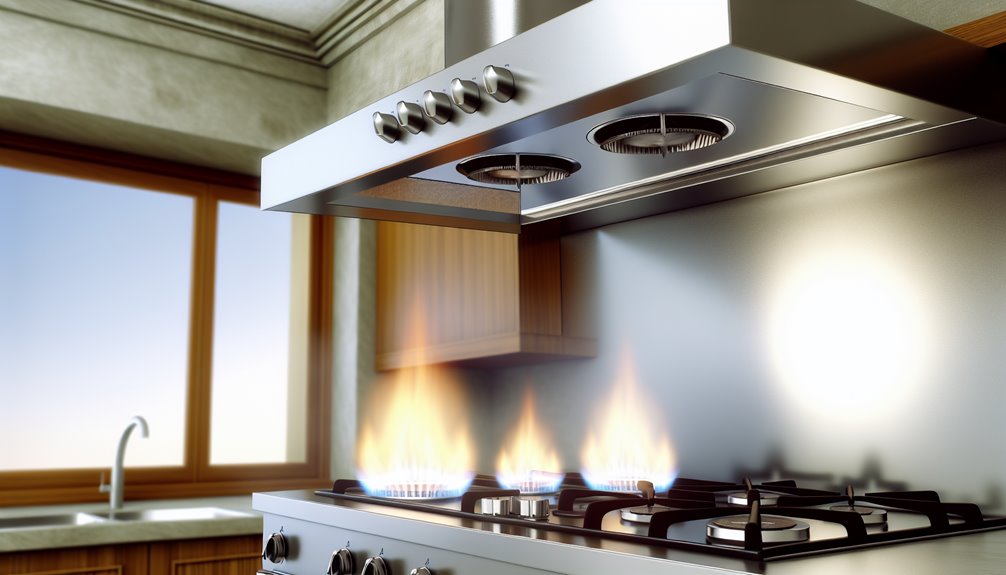Proper ventilation is essential when using a gas stove to guarantee safe cooking and maintain good air quality. You can choose between ducted systems, which vent air outside, and recirculating hoods, which filter and return air. Ducted options generally work better at removing pollutants. Always check for gas leaks, keep flammable items away, and never leave cooking unattended. To learn about effective maintenance and other tips, keep exploring your options for a healthier kitchen.
Key Takeaways
- Ducted ventilation systems effectively remove pollutants by venting air outside, enhancing indoor air quality during cooking.
- Recirculating hoods filter air but may struggle with moisture and odors, suitable for kitchens without ductwork.
- Regularly inspect and maintain your ventilation system to ensure optimal performance and safety.
- Always check for gas leaks before using your stove, and ventilate immediately if a leak is detected.
- Keep flammable materials away from the stove and never leave cooking unattended to prevent accidents.
Importance of Ventilation for Gas Stoves
When you cook with a gas stove, proper ventilation isn’t just a luxury—it’s vital for your health and safety.
Gas stoves release pollutants like carbon monoxide and nitrogen dioxide, which can greatly impact indoor air quality. Breathing in these harmful substances can lead to serious health risks, particularly for vulnerable groups like children and the elderly.
Without adequate ventilation, these gases can accumulate, increasing the likelihood of respiratory issues and other health problems.
By ensuring proper airflow, you not only enhance your cooking experience but also protect yourself and your loved ones.
Types of Ventilation Systems
Proper ventilation is key to maintaining a safe cooking environment, and understanding the different types of ventilation systems can help you make an informed choice for your kitchen.
Ducted systems are one popular option; they vent air outside, effectively removing smoke, odors, and harmful gases. These systems require ductwork, which can be a significant installation effort but is often more effective for long-term air quality.
On the other hand, recirculating hoods filter the air and recirculate it back into your kitchen. They’re easier to install and don’t require ductwork, making them a great choice for apartments or homes without existing ventilation.
Consider your cooking habits and kitchen layout when deciding which system best suits your needs.
Effectiveness of Different Ventilation Options
While both ducted and recirculating ventilation systems have their merits, their effectiveness varies based on several factors.
Ducted ventilation, which expels air outside, generally provides superior performance by removing smoke, heat, and odors more effectively. If you’re using a high-quality range hood, you’ll likely notice a significant reduction in indoor air pollutants, making your kitchen healthier.
On the other hand, recirculating systems filter the air and return it to the kitchen, which can be less effective, especially in heavy cooking situations. They can struggle with moisture and lingering smells.
Ultimately, choosing the right option for your kitchen hinges on your cooking habits and layout, ensuring you enjoy a comfortable cooking environment while maintaining good air quality.
Safe Practices for Using a Gas Stove
Choosing the right ventilation option is just one part of ensuring a safe cooking environment. To further protect yourself, you should adopt several safety measures while using your gas stove. Always check for gas leaks before cooking by smelling for gas or using soapy water on connections. If you detect a leak, turn off the gas and ventilate the area immediately. Keep flammable materials away from the stove, and never leave cooking unattended. Regularly inspect your stove for any signs of wear or damage.
| Safety Measure | Description | Frequency |
|---|---|---|
| Check for gas leaks | Smell or use soapy water | Before each use |
| Clean stove | Remove food debris and grease | Weekly |
| Inspect connections | Look for wear or damage | Monthly |
| Keep flammables away | Maintain distance from the stove | Always |
Maintaining Your Ventilation System
To guarantee your ventilation system operates effectively, it’s vital to perform regular maintenance. Start with routine system inspections to check for any blockages or wear.
Clean the filters and ducts at least every six months to prevent grease buildup that could hinder airflow. If your system uses a fan, verify it’s functioning properly and free from dust and debris.
You should also inspect the venting for any signs of damage or leaks. Don’t forget to check the carbon monoxide detector as well; it’s essential for safety.
Frequently Asked Questions
Can I Use a Gas Stove Without Any Ventilation?
You shouldn’t use a gas stove without ventilation. Poor indoor air quality can arise, compromising gas stove safety. Always guarantee proper airflow to reduce harmful fumes and maintain a healthy cooking environment for yourself and others.
How Often Should I Clean My Vent Hood?
Think of your vent hood as a diligent guardian, tirelessly protecting your kitchen. For ideal vent hood maintenance, you should clean it every month, ensuring grease and grime don’t build up and compromise its efficiency.
What Are Signs of Poor Ventilation in My Kitchen?
If you notice excess humidity, lingering odors, or increased dust, you’re likely facing poor ventilation indicators. These issues can negatively affect your kitchen air quality, making it essential to address ventilation for a healthier cooking environment.
Are Portable Gas Stoves Safe Without Ventilation?
“Where there’s smoke, there’s fire.” Without proper ventilation, using a portable gas stove can be risky. Gas fumes can accumulate, compromising portable stove safety. Always guarantee fresh air circulation to protect yourself from harmful exposure.
Can I Install a Ventilation System Myself?
You can install a ventilation system yourself, but it requires careful planning and understanding of the space. DIY ventilation projects often need specific tools and knowledge, so make sure you research thoroughly before starting your installation.



